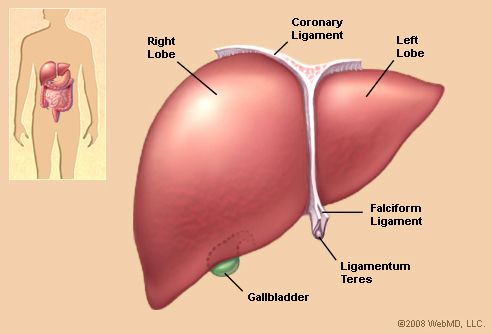Warm Regards
Mohan Lal Kashyap
Picture of the Liver
The liver is a large, meaty organ that sits on the right side of the belly. Weighing about 3 pounds, the liver is reddish-brown in color and feels rubbery to the touch. Normally you can't feel the liver, because it's protected by the rib cage.
The liver has two large sections, called the right and the left lobes. The gallbladder sits under the liver, along with parts of the pancreas and intestines. The liver and these organs work together to digest, absorb, and process food.
The liver's main job is to filter the blood coming from the digestive tract, before passing it to the rest of the body. The liver also detoxifies chemicals and metabolizes drugs. As it does so, the liver secretes bile that ends up back in the intestines. The liver also makes proteins important for blood clotting and other functions.
Liver Conditions
- Hepatitis: Inflammation of the liver, usually caused by viruses like hepatitis A, B, and C. Hepatitis can have non-infectious causes too, including heavy drinking, drugs, allergic reactions, or obesity.
- Cirrhosis: Long-term damage to the liver from any cause can lead to permanent scarring, called cirrhosis. The liver then becomes unable to function well.
- Liver cancer: The most common type of liver cancer, hepatocellular carcinoma, almost always occurs after cirrhosis is present.
- Liver failure: Liver failure has many causes including infection, genetic diseases, and excessive alcohol.
- Ascites: As cirrhosis results, the liver leaks fluid (ascites) into the belly, which becomes distended and heavy.
- Gallstones: If a gallstone becomes stuck in the bile duct draining the liver, hepatitis and bile duct infection (cholangitis) can result.
- Hemochromatosis: Hemochromatosis allows iron to deposit in the liver, damaging it. The iron also deposits throughout the body, causing multiple other health problems.
- Primary sclerosing cholangitis: A rare disease with unknown causes, primary sclerosing cholangitis causes inflammation and scarring in the bile ducts in the liver.
- Primary biliary cirrhosis: In this rare disorder, an unclear process slowly destroys the bile ducts in the liver. Permanent liver scarring (cirrhosis) eventually develops.
Liver Tests
Blood Tests:
- Liver function panel: A liver function panel checks how well the liver is working and consists of many different blood tests.
- ALT (Alanine Aminotransferase): An elevated ALT helps identify liver disease or damage from any number of causes, including hepatitis.
- AST (Aspartate Aminotransferase): Along with an elevated ALT, the AST checks for liver damage.
- Alkaline phosphatase: Alkaline phosphatase is present in bile-secreting cells in the liver; it's also in bones. High levels often mean bile flow out of the liver is blocked.
- Bilirubin: High bilirubin levels suggest a problem with the liver.
- Albumin: As part of total protein levels, albumin helps determine how well the liver is working.
- Ammonia: Ammonia levels in the blood rise when the liver is not functioning properly.
- Hepatitis A tests: If hepatitis A is suspected, the doctor will test liver function as well as antibodies to detect the hepatitis A virus.
- Hepatitis B tests: Your doctor can test antibody levels to determine if you have been infected with the hepatitis B virus.
- Hepatitis C tests: In addition to checking liver function, blood tests can determine if you have been infected with the hepatitis C virus.
- Prothrombin Time (PT): A prothrombin time, or PT, is commonly done to see if someone is taking the correct dose of the blood thinner warfarin (Coumadin). It also checks for blood clotting problems.
- Partial Thromboplastin Time (PTT): A PTT is done to check for blood clotting problems.
Imaging Tests:
- Ultrasound: An abdominal ultrasound can test for many liver conditions, including cancer, cirrhosis, or problems from gallstones.
- CT scan (computed tomography): A CT scan of the abdomen gives detailed pictures of the liver and other abdominal organs.
- Liver biopsy: A liver biopsy is most commonly done after another test, such as a blood test or ultrasound, indicates a possible liver problem.
- Liver and spleen scan: This nuclear scan uses radioactive material to help diagnose a number of conditions, including abscesses, tumors, and other liver function problems.

No comments:
Post a Comment